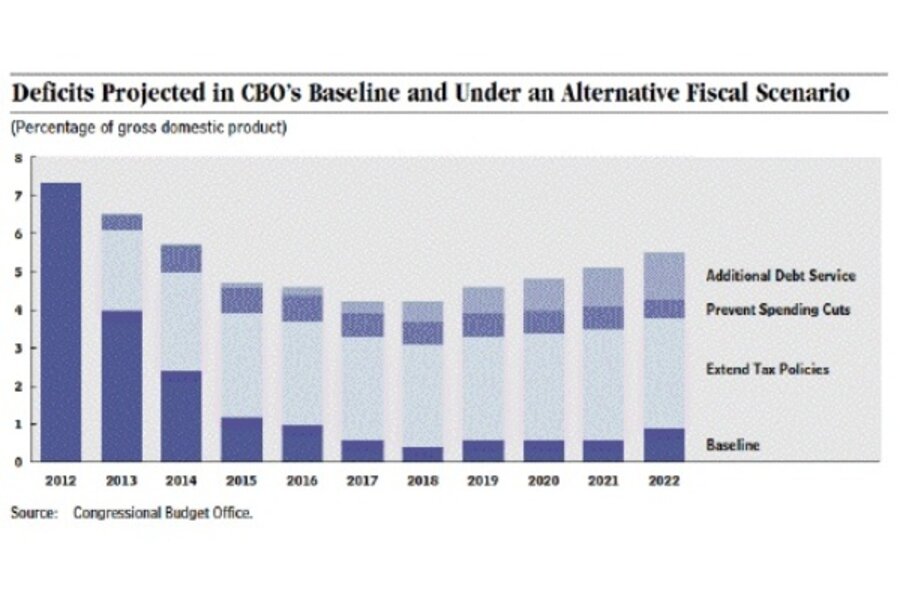Fiscal cliff vs. tax-cut extension is gloom or doom. Is there another way?
Loading...
The Congressional Budget Office’s summer budget update charts two undesirable paths for the nation’s economic and fiscal health next year. Call them Gloom and Doom.
Gloom is what happens if the tax increases and government spending cuts scheduled to arrive in January actually occur. CBO says that would drive the economy back into recession in 2013 and push unemployment above 9 percent. But there’s some sunshine too: the federal deficit would drop sharply—by nearly half in 2013 alone—and would be under 1 percent of GDP by 2016 (dark blue bars in graph). The federal debt would decline from 73 percent of GDP this year to 59 percent in 2022. And the economy would resume growing in a year or so. Long-term gain for short term pain.
Doom occurs if Congress and the president agree to extend all of the expiring tax cuts and postpone the scheduled spending cuts for the next ten years. Short-term extension would prevent renewed economic collapse—the economy would maintain its slow growth and unemployment would continue its slow downward trend. But deficits would fall much less (the sum of the bars in the graph) and government debt would climb to nearly 90 percent of GDP in 2022.
Gloom and Doom aren’t new to the scene. Our recovery from the great recession has crawled at a painfully slow pace and any fiscal hit could stop it in its tracks. When faced with expiring tax cuts in 2010, President Obama and Congress agreed to extend the cuts through 2012, buying time for the recovery at a cost of two more annual deficits exceeding a trillion dollars. That set the stage for this year’s fiscal cliff.
Meanwhile we’ve had ample warning about our deficit and debt problems. Cutting taxes without controlling spending has proved to be a sure recipe for growing debt. Add burgeoning costs of Medicare and Medicaid, the demographic bulge of baby boomers collecting Social Security, and the cost of two wars, and the debt had to rise—and at an increasing pace. CBO has warned for years about the looming fiscal crisis, even before the recession piled on costs and slashed revenues.
We don’t really have to choose between Gloom and Doom. Combining smaller, well-timed parts of each would be a better alternative. We just need to figure out how to segue from not squelching our nascent economic recovery in the short run to accepting the fiscal discipline required to control deficits and bring down our national debt.
CBO’s update isn’t news. It’s just another reminder that we can’t continue to spend too much and tax too little, despite what presidential and congressional candidates might want us to think.







